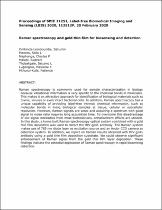JavaScript is disabled for your browser. Some features of this site may not work without it.
- ResearchSpace
- →
- Research Publications/Outputs
- →
- Conference Publications
- →
- View Item
| dc.contributor.author |
Ombinda-Lemboumba, Saturnin

|
|
| dc.contributor.author |
Manoto, Sello L

|
|
| dc.contributor.author |
Maphanga, Charles P

|
|
| dc.contributor.author |
Malabi, Rudzani

|
|
| dc.contributor.author |
Thobakgale, Setumo L

|
|
| dc.contributor.author |
Lugongolo, Masixole Y

|
|
| dc.contributor.author |
Mthunzi-Kufa, Patience

|
|
| dc.date.accessioned | 2020-06-03T10:47:48Z | |
| dc.date.available | 2020-06-03T10:47:48Z | |
| dc.date.issued | 2020-02 | |
| dc.identifier.citation | Ombinda-Lemboumba, S. et al. 2020. Raman spectroscopy and gold thin film for biosensing and detection. Proceedings of SPIE 11251, Label-free Biomedical Imaging and Sensing (LBIS) 2020, 112512P, 20 February 2020 | en_US |
| dc.identifier.isbn | 9781510632653 | |
| dc.identifier.isbn | 9781510632660 | |
| dc.identifier.issn | 1605-7422 | |
| dc.identifier.issn | 2410-9045 | |
| dc.identifier.uri | https://doi.org/10.1117/12.2546617 | |
| dc.identifier.uri | http://hdl.handle.net/10204/11442 | |
| dc.description | Copyright: 2020 SPIE. Due to copyright restrictions, the attached pdf contains the abstract of the published paper only. For access to the fulltext paper, kindly consult the publisher's website: https://doi.org/10.1117/12.2546617 | en_US |
| dc.description.abstract | Raman spectroscopy is commonly used for sample characterization in biology because vibrational information is very specific to the chemical bonds in molecules. This makes it an attractive approach for identification of biological materials such as toxins, viruses or even intact bacterial cells. In addition, Raman spectroscopy has a unique capability of providing label-free intrinsic chemical information, such as molecular bonds in living biological samples at tissue, cellular or subcellular resolution. However, Raman signals are weak and acquiring a spectrum with good signal to noise ratio requires long acquisition time. To overcome this disadvantage of low signal intensities from most biomolecules, enhancement effects are utilized. In this study, a home built Raman spectroscopy optical system combined with a gold thin film deposition was used to detect the HIV gp41 antibody. The Raman system makes use of 785 nm diode laser as excitation source and an Andor CCD camera as detection system. In addition, we report on Raman results obtained with HIV gp41 antiboby using a gold thin film deposition substrate. We could observe significant enhancement of Raman signal from the gold thin film layer deposition. These findings indicate the potential application of Raman spectroscopy in rapid biosensing detection. | en_US |
| dc.language.iso | en | en_US |
| dc.publisher | SPIE | en_US |
| dc.relation.ispartofseries | Worklist;23526 | |
| dc.subject | Raman Spectroscopy | en_US |
| dc.subject | Gold thin films | en_US |
| dc.subject | HIV | en_US |
| dc.subject | Biosensing | en_US |
| dc.title | Raman spectroscopy and gold thin film for biosensing and detection | en_US |
| dc.type | Conference Presentation | en_US |
| dc.identifier.apacitation | Ombinda-Lemboumba, S., Manoto, S. L., Maphanga, C. P., Malabi, R., Thobakgale, S. L., Lugongolo, M. Y., & Mthunzi-Kufa, P. (2020). Raman spectroscopy and gold thin film for biosensing and detection. SPIE. http://hdl.handle.net/10204/11442 | en_ZA |
| dc.identifier.chicagocitation | Ombinda-Lemboumba, Saturnin, Sello L Manoto, Charles P Maphanga, Rudzani Malabi, Setumo L Thobakgale, Masixole Y Lugongolo, and Patience Mthunzi-Kufa. "Raman spectroscopy and gold thin film for biosensing and detection." (2020): http://hdl.handle.net/10204/11442 | en_ZA |
| dc.identifier.vancouvercitation | Ombinda-Lemboumba S, Manoto SL, Maphanga CP, Malabi R, Thobakgale SL, Lugongolo MY, et al, Raman spectroscopy and gold thin film for biosensing and detection; SPIE; 2020. http://hdl.handle.net/10204/11442 . | en_ZA |
| dc.identifier.ris | TY - Conference Presentation AU - Ombinda-Lemboumba, Saturnin AU - Manoto, Sello L AU - Maphanga, Charles P AU - Malabi, Rudzani AU - Thobakgale, Setumo L AU - Lugongolo, Masixole Y AU - Mthunzi-Kufa, Patience AB - Raman spectroscopy is commonly used for sample characterization in biology because vibrational information is very specific to the chemical bonds in molecules. This makes it an attractive approach for identification of biological materials such as toxins, viruses or even intact bacterial cells. In addition, Raman spectroscopy has a unique capability of providing label-free intrinsic chemical information, such as molecular bonds in living biological samples at tissue, cellular or subcellular resolution. However, Raman signals are weak and acquiring a spectrum with good signal to noise ratio requires long acquisition time. To overcome this disadvantage of low signal intensities from most biomolecules, enhancement effects are utilized. In this study, a home built Raman spectroscopy optical system combined with a gold thin film deposition was used to detect the HIV gp41 antibody. The Raman system makes use of 785 nm diode laser as excitation source and an Andor CCD camera as detection system. In addition, we report on Raman results obtained with HIV gp41 antiboby using a gold thin film deposition substrate. We could observe significant enhancement of Raman signal from the gold thin film layer deposition. These findings indicate the potential application of Raman spectroscopy in rapid biosensing detection. DA - 2020-02 DB - ResearchSpace DP - CSIR KW - Raman Spectroscopy KW - Gold thin films KW - HIV KW - Biosensing LK - https://researchspace.csir.co.za PY - 2020 SM - 9781510632653 SM - 9781510632660 SM - 1605-7422 SM - 2410-9045 T1 - Raman spectroscopy and gold thin film for biosensing and detection TI - Raman spectroscopy and gold thin film for biosensing and detection UR - http://hdl.handle.net/10204/11442 ER - | en_ZA |






